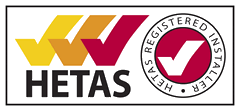Chimney sweeping & Problems
We are chimney specialists and prov![]() ide a service for diagnosing and solving the many chimney problems you may experience. Most chimney problems are resultant of poorly maintained chimneys, we recommend that you get your chimney swept at least once a year, prior to the autumn/winter season, and twice a year if you use your fire throughout the year.
ide a service for diagnosing and solving the many chimney problems you may experience. Most chimney problems are resultant of poorly maintained chimneys, we recommend that you get your chimney swept at least once a year, prior to the autumn/winter season, and twice a year if you use your fire throughout the year.
The following paragraphs highlight the workings and the most commonly encountered problems with chimneys, stove flues and open fireplaces. Many of these problems are the result of inefficient, poorly maintained or deteriorating chimneys.
If you experience any of these issues contact us immediately
The fire is not drawing properly
This is usually the result of a cold (flues take a little time to warm up and work correctly) or an obstructed flue or it may even be because of an insufficient height compared to the ridge of the roof or an nearby building. Sometimes double glazing and very efficient draught excluders around doors, etc, may prevent an adequate flow of air for the fire to work correctly. If no other work has taken place and the fire suddenly does not draw properly you should have the flue checked for obstructions and probably swept at the same time.
The customer asked us to replace the cowl on their other chimney as they might use it in future. The photo on the right above shows both cowls, one chimney was in use the other wasn't |
The fire creates a large amount of soot
This usually means you have an inefficient flue. This may be because the flue is not the right diameter for the fire or stove, or may it not be satisfactorily insulated so that the fumes do not rise fast enough and therefore create soot deposits on the inside. Excessive soot and tar can be a considerable fire hazard, particularly if the chimney structure has deteriorated or where, on the older house for example, the floor joists have been built into the stack,. In this case the whole house can be at risk. Again, the first step would be to have the chimney swept and ask a qualified chimney installer to check the flue - possibly by carrying out a smoke test to make sure that the fumes will rise swiftly and efficiently.
Falling Debris
Bits of brick or mortar debris falling down the chimney flue indicates a decay in its structure. The debris could be small pieces of brick, sand, tar or soot or lumps of mortar. This problem can be easily fixed by patching or replacing old broken bricks, and re-tarring the flue.
Heated Chimney Openings
When the chimney openings in adjoining or above wall heats up, it is a sign of flue deterioration. A common symptom of this problem is dull black stains that begin to appear on its opening, caused due to condensed tar or acids in the flue, that are damaging to the brickwork of the chimney.
Not Enough Fire
When fire is not drawn adequately, it is caused due to obstructed flue or when the height of the chimney is insufficient in relation to the ridge of the roof. However, just increasing the height of the chimney will not alone help to draw out enough fire, and it needs to be combined with clearing the flue obstruction.
Fumes in the Rooms
Chimney fumes containing carbon monoxide (CO) is dangerous and capable of killing. Even lower levels of CO concentration can cause dizziness, mental confusion, severe headaches, nausea and fainting. Many times, a leaky chimney will send fumes all over the house. This kind of a problem requires the immediate attention of a qualified technician. Call us immediately
Too Much Fuel
Un insulated flues require a lot of fuel to draw heat. When small outlet fume pipes, discharge into large un insulated flue, they won't rise up. To accelerate their ascent, they consume more fuel. An insulated flue of the correct size will solve excess fuel consumption problems.
Dampness in the Chimney
A damp chimney will stain the ceiling and the chimney opening, as well as walls around the fireplace. This could be caused due to a number of factors that trap moisture, mainly, porous clay bricks, un vented flue, rain water, etc.
Interior versus Exterior Chimneys
A chimney in the centre of a house is kept warm on all four sides by the warmth of the house. This situation generally enables very good and consistent draft in the chimney. An exterior chimney, one on an outside wall, has at least one surface that is exposed to the cold outside air. This has the effect of chilling the chimney and making it harder for the chimney structure to stay warm enough to provide consistent draft inside the chimney. Most outside chimneys are actually physically placed outside the wall of the house (to take up less floor space in the house) which cause three sides of the chimney to be exposed to the cold outside air.
Science is not much good here, but it seems that many people think that an interior chimney draws about 20% better than exterior chimneys. In the case of a chimney that is close to the line of being under-sized that can make the difference between smoking or not. It also makes a major difference in first getting a fire started and getting the chimney to begin to draw.
If it is possible to get into the space around the body of the fireplace and chimney, it might be possible to install non-combustible fiberglas insulation in such a hollow chase. This should only be considered after making sure that the chimney manufacturer's clearances and installation requirements, and those of the fireplace manufacturer, are followed. A case might exist where adding such insulation might clog some necessary opening in a fireplace or chimney or otherwise cause it to dangerously overheat, so always check required clearances first.

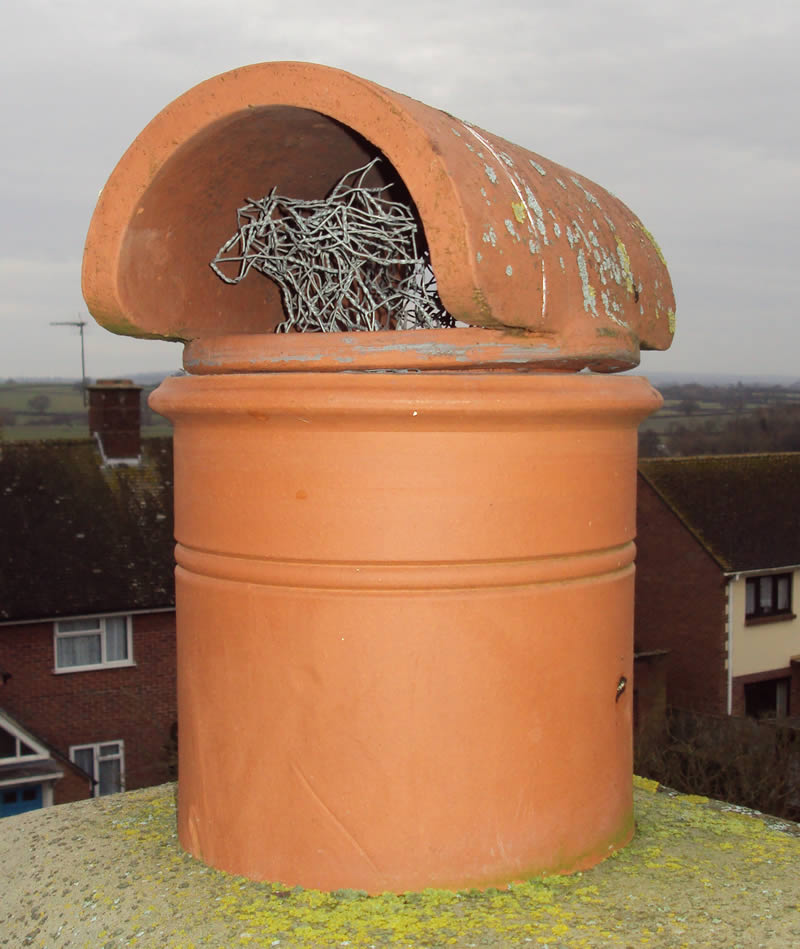 The customer had an open fire that worked fine for the last couple of years but during the latest cold spell they started to get smoke back into the room. We went to investigate the problem, no changes had been made to the house or chimney so as a first thing to do was to sweep the chimney; even though they had a 'chimney sweep' in a month before. We extracted half a bag of soot from the chimney even though they only had a couple of small fires since the last sweep.
The customer had an open fire that worked fine for the last couple of years but during the latest cold spell they started to get smoke back into the room. We went to investigate the problem, no changes had been made to the house or chimney so as a first thing to do was to sweep the chimney; even though they had a 'chimney sweep' in a month before. We extracted half a bag of soot from the chimney even though they only had a couple of small fires since the last sweep.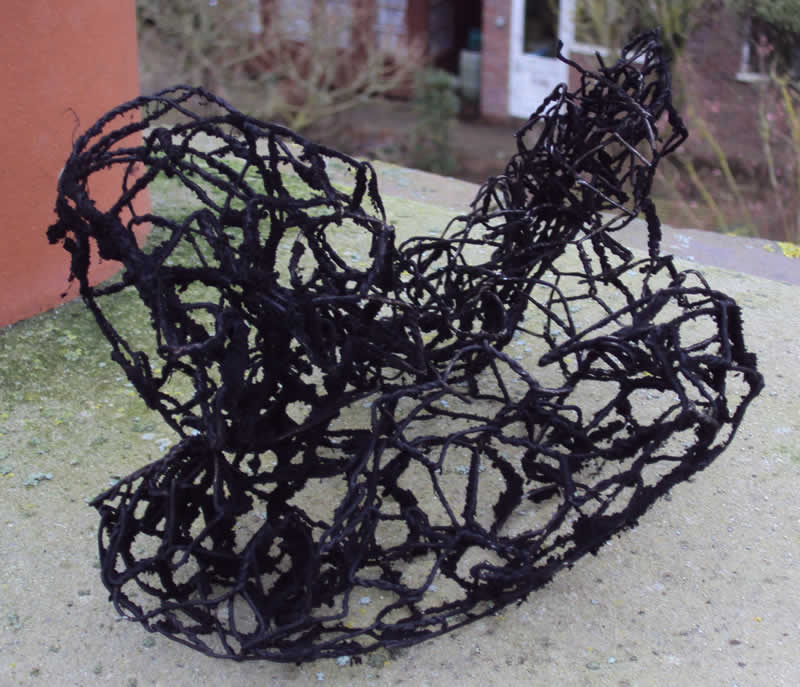 The type of cowl fitted was a Bonnet Top (above) which is not recommended for stoves or open fires as it restricts the air flow. Furthermore the previous installer had used rolled up chicken wire to protect against birds nesting; this had blocked up from soot thrown up by the fire (left) and restricted the flow further causing the smoking problem.
The type of cowl fitted was a Bonnet Top (above) which is not recommended for stoves or open fires as it restricts the air flow. Furthermore the previous installer had used rolled up chicken wire to protect against birds nesting; this had blocked up from soot thrown up by the fire (left) and restricted the flow further causing the smoking problem.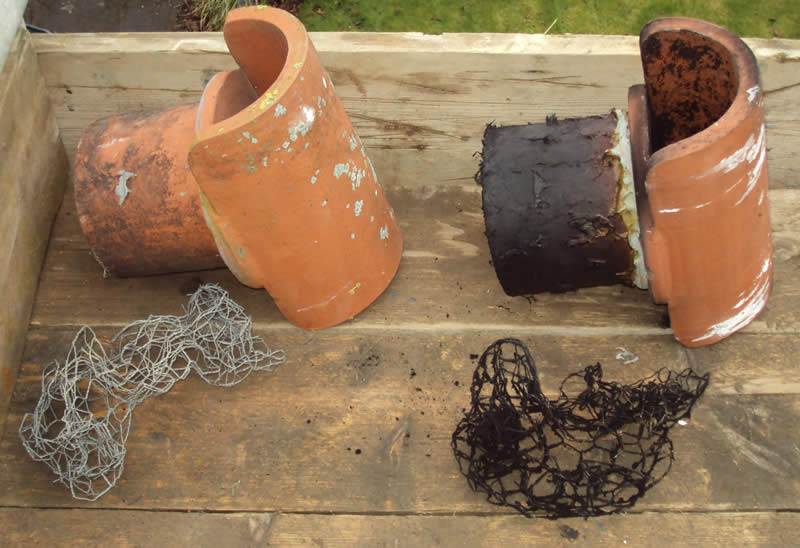 We recommended that the cowl was replaced with one designed for open fires that has
We recommended that the cowl was replaced with one designed for open fires that has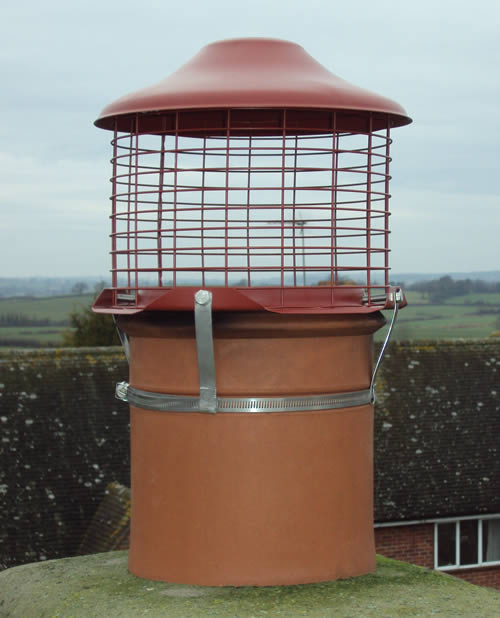 a large open mesh that will not block (left).
a large open mesh that will not block (left). 